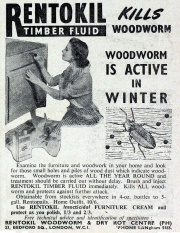of 168-170 Stockwell Road, London, W9. Telephone: Brixton 6426-7 (1947)
Centre of Maidenhead, Berkshire (2007)
1924 A small company was set up by Harold Maxwell-Lefroy, professor of entomology at Imperial College London, and his assistant Elizabeth Eades who had developed an anti-woodworm fluid called Ento-Kill. Since a similar name had already been registered as a trade name, Lefroy instead named his insecticide Rentokil.
1925 Lefroy was killed in his laboratory (one source says due to exposure to insecticide; another says due to a fire); his assistant Elizabeth Eades took over the company. By providing a reliable service, the company soon started to grow.
1926 The Rentokil company was incorporated as a private company[1].
1939 When war broke out, measures were needed to protect the nation's dwindling food stores, which could not afford any losses to pests. Rentokil began offering its own extermination services.
In the post-war years, Rentokil continued to thrive, gradually expanding into other businesses.
1947 British Industries Fair Advert as Manufacturers of: Insecticides; Germicides; Insect Repellent and Powders; Timber Fluid for the destruction of Wood Worm. Furniture Cream, Dry Cleaner, Pets Insect Powders, Biting Insect Repellent, Mothproofer. (Chemicals Section - Olympia, Ground Floor, Stand No. A.1133) [2]
1952 The subsidiary Woodworm and Dry Rot Control Ltd. was established to bring together the work on woodworm and dry rot control
1957 British Ratin, of which Sophus Berendsen was still its major shareholder, acquired Rentokil Ltd.
1960 The combined company was reorganized, adopting the new name of Rentokil Group Ltd.
1962 The main UK subsidiary, Chelsea Insecticides was renamed Rentokil Laboratories Ltd.
Acquired Rashbrooke Chemica and Thames Services, taking the group into the fields of hygiene and property maintenance.[3]
1969 Public company. Offer of ordinary shares.
1978 After controlling shareholder Sophus Berendsen sold a few shares the company was no longer a "close" company[4]
1989 Sophus Berendsen still owned 55 percent of the shares[5]
1996 Acquired BET after a hostile take-over bid. The merged company was named Rentokil Initial, by including the name of one of BET's subsidiaries.
See Also
Sources of Information
- [1] Rentokil history
- The Times March 7, 1969















